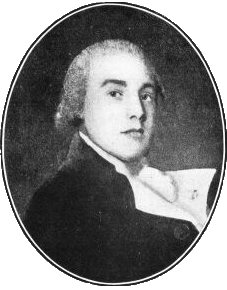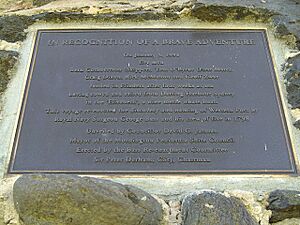George Bass facts for kids
Quick facts for kids
George Bass
|
|
|---|---|

Engraving of Bass from The Naval Pioneers of Australia by Louis Becke and Walter Jeffery, 1899
|
|
| Born | 30 January 1771 Sleaford, Lincolnshire, England
|
| Disappeared | 5 February 1803 (aged 32) Last seen before leaving Port Jackson, New South Wales, Australia |
| Nationality | British |
| Occupation | Ship's surgeon and explorer |
| Spouse(s) | Elizabeth Waterhouse |
George Bass was a brave British explorer and a ship's doctor. He was born on January 30, 1771, and disappeared after February 5, 1803. He is famous for exploring the coast of Australia and proving that Tasmania was a separate island.
Contents
George Bass's Early Life
George Bass was born in a small village near Sleaford, England. His father was a farmer, and his mother was named Sarah. Sadly, his father died when George was only six years old.
George went to Boston Grammar School and later studied medicine. When he was 18, he became a surgeon. In 1794, he joined the Royal Navy as a ship's doctor.
On September 7, 1795, George Bass arrived in Sydney, New South Wales, aboard the ship HMS Reliance. On this journey, he met Matthew Flinders, who would become a good friend and fellow explorer.
Exploring in Small Boats
George Bass brought a tiny boat with him to Australia. It was only about 8 feet (2.4 meters) long and 5 feet (1.5 meters) wide. He called it the Tom Thumb because it was so small.
In October 1795, Bass and Flinders, along with another crew member, sailed the Tom Thumb to Botany Bay. They explored the Georges River. Their discoveries helped lead to the creation of a new settlement called Banks' Town.
In March 1796, they took a second, slightly larger boat, which they named the Tom Thumb II. They sailed south along the coast to Lake Illawarra. They also explored Port Hacking.
Later in 1796, Bass found good land for farming near Prospect Hill. He also found cattle that had been lost since 1788. He even tried to cross the Blue Mountains, but it was too difficult.
A Big Journey in a Small Boat
In 1797, George Bass went on a very long and dangerous journey. He and six crew members sailed an open whaleboat to Cape Howe, which is the most south-eastern point of Australia. From there, they continued west to Western Port.
Bass believed that Van Diemen's Land (now Tasmania) was not connected to mainland Australia. He watched the ocean tides and the strong waves at Wilson's Promontory. This convinced him that his idea was correct and there was a strait (a narrow passage of water) separating the two landmasses.
During this trip, Bass also visited the Kiama area in New South Wales. He wrote notes about the many plants and the amazing Kiama Blowhole, a natural rock formation where water shoots high into the air.
Proving Tasmania Was an Island
In 1798, Bass and Flinders sailed a ship called the Norfolk all the way around Van Diemen's Land. This journey proved that it was indeed an island, just as Bass had suspected.
They visited the mouth of the Derwent River, which had been found earlier by Captain John Hayes. Bass wrote a report about this area, which led to it being chosen for the future city of Hobart in 1803.
When they returned to Sydney, Flinders suggested to Governor John Hunter that the passage between Van Diemen's Land and the mainland should be named Bass Strait. Flinders said this was a fair way to honor his friend for his hard work and good judgment.
Bass also sent some of the new plants he found to Sir Joseph Banks in London. He was made an honorary member of a science society. Bass was also one of the first people to describe the Australian wombat, a furry marsupial.
Marriage and Trading Adventures
On October 8, 1800, George Bass married Elizabeth Waterhouse in England. She was the sister of Henry Waterhouse, who had been Bass's shipmate. Sadly, George left for Australia again in January 1801 and never saw Elizabeth again. They wrote letters to each other, but he never returned from his journey.
Bass and some friends had invested a lot of money in a ship called the Venus. They filled it with goods to sell in Port Jackson (Sydney Harbour).
When Bass arrived in Sydney, he found that many other people had also brought goods to sell. He couldn't sell his cargo easily. Governor King asked Bass to get salted pork from Tahiti instead. There was not much food in Sydney, but plenty of pigs in the Society Islands. This deal worked well for both of them.
Bass sailed from Sydney in the Venus to New Zealand. They spent 14 days taking iron from an old shipwreck. They turned this iron into axes, which they used to trade for pork in Tahiti. They returned to Sydney in November 1802.
In January 1803, Bass asked Governor King for the rights to all the fish along the South Island of New Zealand. He also wanted to include the lands and seas to the south, like the Antipodes Islands. He likely heard about the good fishing there from his brother-in-law, Waterhouse.
George Bass's Final Voyage
Bass set sail on his last voyage in the Venus on February 5, 1803. He and his crew were never seen again. His plan was to go to Tahiti and then possibly to the Spanish colonies on the coast of Chile. He wanted to buy supplies and bring them back to Sydney.
It's also possible that Bass planned to smuggle goods into Chile. At that time, Spain only allowed Spanish ships to bring goods into the country. But the people in Chile needed more supplies than they could get, and prices were very high. This made smuggling very profitable.
Bass still had many goods he had brought to Sydney in 1801. He might have been tempted to try and sell them in Chile. In his last letters, he hinted at a secret plan he couldn't name. He left with a letter from Governor King saying his only purpose in South America was to get supplies.
He was never heard from again. In England, in January 1806, the navy officially listed him as lost at sea. His wife, Elizabeth, received money from a fund for widows.
What Might Have Happened?
There are many ideas about what happened to George Bass. One story says that he was captured by the Spanish in Chile and forced to work in silver mines. However, this story came out much later and doesn't seem to fit with the timeline of events. Also, all British prisoners held by the Spanish in Chile were freed in 1808, and none of Bass's crew were among them.
Another adventurer wrote in 1835 that Bass tried to force trade at gunpoint in Chile and was captured. While this writer might have met Bass, his stories were often not completely true.
Historians have searched Spanish and Peruvian records, but they have found no mention of George Bass or his ship. His final fate remains a mystery.
Remembering George Bass
George Bass has been honored in Australia in many ways. In 1963, he was featured on a postage stamp issued by Australia Post. He was honored again in 1998, this time with Matthew Flinders.
To celebrate the 200th anniversary of Bass's whaleboat journey, a re-enactment was made. A boat called the "Elizabeth" arrived at Western Port on January 5, 1998, just like Bass had done centuries before.
Many places in Australia are named after George Bass, including:
- Bass Highway (Tasmania)
- Bass Highway (Victoria)
- Bass Hill, New South Wales
- Bass Point
- Bass Strait
- Bass River
- Bass, Victoria (a town)
- Division of Bass, Tasmania (a federal election area)
- Bass and Flinders Point, Cronulla, New South Wales
- George Bass Drive, Moruya, New South Wales
|
See also
 In Spanish: George Bass para niños
In Spanish: George Bass para niños




